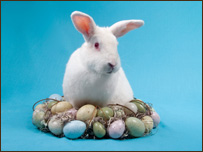Take Away English-Easter Traditions 复活节习俗(在线收听)

Which came first - the rabbit or the egg?
|
Although Easter is widely seen as a Christian festival which celebrates the resurrection of Jesus, its origins pre-date Christianity and many of its symbols come from the earliest civilisations.
Our modern festival’s roots lie in ancient seasonal rituals which marked the transition from the "death" of winter to the new life and rebirth of spring.
These days we give chocolate eggs as gifts at Easter but eggs have been symbols of fertility for thousands of years.
The ancient Persians gave each other painted eggs for the festival of Nowrooz, a celebration held at the spring equinox which marked the start of Persian New Year. The tradition continues to this day.
Centuries ago the early Saxon people marked buns with a cross to honour their goddess Eostre, whose name some people believe to be the origin of the word Easter. It is believed that early Christians incorporated such pagan festivals into their religion.
Some experts say the Easter bunny was originally a hare as this animal represented fertility and growth in pagan mythology due to its capacity for reproduction. Moreover, in some ancient cultures the hare was also a symbol of the moon, which is significant as the date of Easter changes each year depending on the lunar cycle.
The Easter bunny has become an important symbol of Easter all over the world. But nowadays not everybody treats such symbols with respect.
Pranksters in the Austrian town of Villach have stolen a giant Easter Bunny from the town square. Local police say it should not be too difficult to spot as it is two metres tall and weighs 60kg.
|
GLOSSARY 词汇表 |
|
|
Easter eggs Easter bunnies symbols rebirth ancient Persians Saxon goddess hare ancient cultures pranksters |
hot-cross buns resurrection seasonal rituals symbols of fertility spring equinox buns pagan mythology lunar cycle to spot |